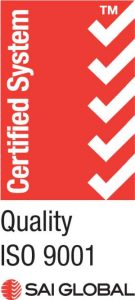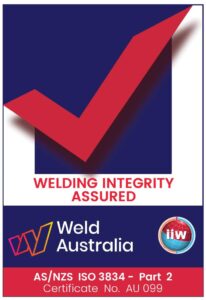Welding Terminology & Abbreviations: What does MIG, TIG, FCAW, SMAW, GMAW Stand For In Welding?

MIG – ‘MIG’ stands for ‘Metal Inert Gas’ welding, but you might also see it referred to as ‘GMAW’ (‘Gas Metal Arc Welding’), or ‘MAG’ (‘Metal Active Gas’ welding). This is one of the most common welding techniques – and one of the easiest to learn – so it’s great for both beginners and large-scale production.
MIG – uses a consumable electrode and an argon-carbon dioxide shielding gas to create strong welds on both thin and thick sheets of metal.
TIG – ‘TIG’ stands for ‘Tungsten Inert Gas’ welding, which is the same as ‘GTAW’ (‘Gas Tungsten Arc Welding’). On paper, TIG seems quite similar to MIG, except that the electrode is non-consumable and the shielding gas typically has an argon-helium composition.
TIG is a more difficult process to master than MIG as it needs a more precise technique. As a result, it’s usually used by more experienced welders or for delicate projects which require a clean finish.
FCAW – ‘FCAW’ stands for ‘Flux-Cored Arc Welding.’ This process uses different equipment to MIG and TIG welding because although the electrode is a continuously-fed consumable one (like with MIG), it has a flux at its core. This flux eliminates the need for separate shielding gas, which means that it’s suitable for outdoor projects and windy conditions.
FCAW can produce dangerous gases, so it’s essential to wear adequate protection such as a welding helmet. However, if proper care is taken with safety as well as technique, then FCAW is a brilliantly fast, portable process which is ideal for manufacturing.
SMAW – ‘SMAW’ stands for ‘Shielded Metal Arc Welding,’ but you might commonly hear it being referred to as ‘stick welding.’ Like FCAW, SMAW uses flux to protect the weld pool from damaging atmospheric gases – the only difference is that in SMAW the flux coats the electrode, whereas with FCAW it’s at the center
SMAW is a slightly more natural process to learn than FCAW as it requires less equipment and a less refined technique. It can be used with most metals – including thick, industrial steel and iron – making it one of the most popular and widely used welding techniques ever.
GMAW – ‘GMAW’ stands for ‘Gas Metal Arc Welding,’ which is a term that encompasses both MIG and MAG welding. All three of these processes use the same method of forming an electric arc between an electrode and the metal. This heats the metal and causes it to melt, creating a joint which fuses the metal pieces together.
GMAW needs a shielding gas to protect the weld pool from atmospheric gases, so it isn’t suited to outdoor projects. This is because if any wind blows the gas away from the weld pool, you will end up with defective, porous joints. However, when used indoors GMAW is an incredibly versatile process.
There is a long list of other abbreviations which you might come across during your welding career. Here is a small selection of some of the most common:
AC – Alternating Current
AWS – American Welding Society
BMAW – Bare Metal Arc Welding
BS – British Standards
BW – Braze Welding
GMAC – Gas Metal Arc Cutting
DC – Direct Current
DCEN – Direct Current Electrode Negative
DCEP – Direct Current Electrode Positive
PAW – Plasma Arc Welding
RSW – Resistance Spot Welding
SMAC – Shielded Metal Arc Cutting (Also known as ‘hot rodding’)
STUD – Stud Welding
WFS – Wire Feed Speed
How much does welding pay?

As with most jobs, a welder’s salary depends a lot on their skill and experience levels.
Newly qualified welders who don’t have much experience will start out with a pretty basic salary, somewhere around the $10-$14 per hour mark. However, as your level of experience rises, so will your pay.
On average, a welder’s hourly pay is usually around $20 per hour, but this takes into account both beginners and the very highest earners. At the top end of the scale, very skilled, highly-qualified welders can earn $30-$40 per hour.=
In general, the farthest locations and the most dangerous jobs carry the highest salaries, as of making offshore oil rig contracts. However, it’s up to you to weigh up whether the extra income is worth the risk, long hours and time spent away from home.
It’s also worth bearing in mind that some specialized jobs (such as those involving underwater or pipe welding) will only keep you busy for a few months at a time. Although you might earn a significant income over the course of a few months, as soon as the contract ends you might find yourself bringing in nothing until you see the next welding gig. Some welders like having these breaks between jobs, while others don’t like the feeling of uncertainty which this type of work can bring.
Whether you’re a new welder or someone who’s been in the game for a few years, there are always things that you can do to increase your wage. Do as much training and gain as many qualifications as you can, as this will attract employers’ attention and make it clear that you know your stuff. The initial outlay for the course fees might seem high, but you’ll quickly make your money back with the extra pay that you earn.
Similarly, if you have a broad skill level then you’ll appeal to more employers, so try to perfect as many different welding techniques as possible. This also means that if demand drops in one particular field, you won’t be left wondering where to turn in your career, as you’ll already be qualified and experienced enough to move into another area.
The location also plays a big part in a welder’s salary, so it’s worth carefully considering whether you’re in the best place for your career. For example, wages in Alaska average out at double the fees that welders earn in South Dakota, so do your research to find out where the highest paying jobs will take you. It stands to reason that the parts of the country with a high demand for welders will pay more, so it’s really worth considering a move if you’re able to do so.
How much does underwater and pipeline welding pay?
Underwater and pipeline welding are more specialized techniques which need more training and carry higher risks, so naturally, these are higher earning areas.
The average underwater welder’s salary usually falls at around $24 per hour, which works out to about $54,000 per year. Low earners might only see $30,000 per year, while the top earners can rake in £90,000 or more. It isn’t uncommon for very experienced underwater welders to bring home six figures.

